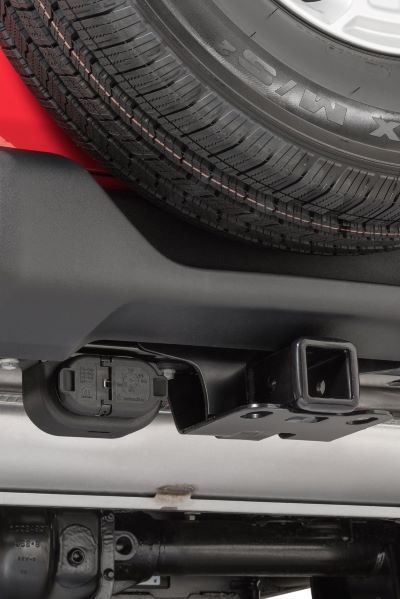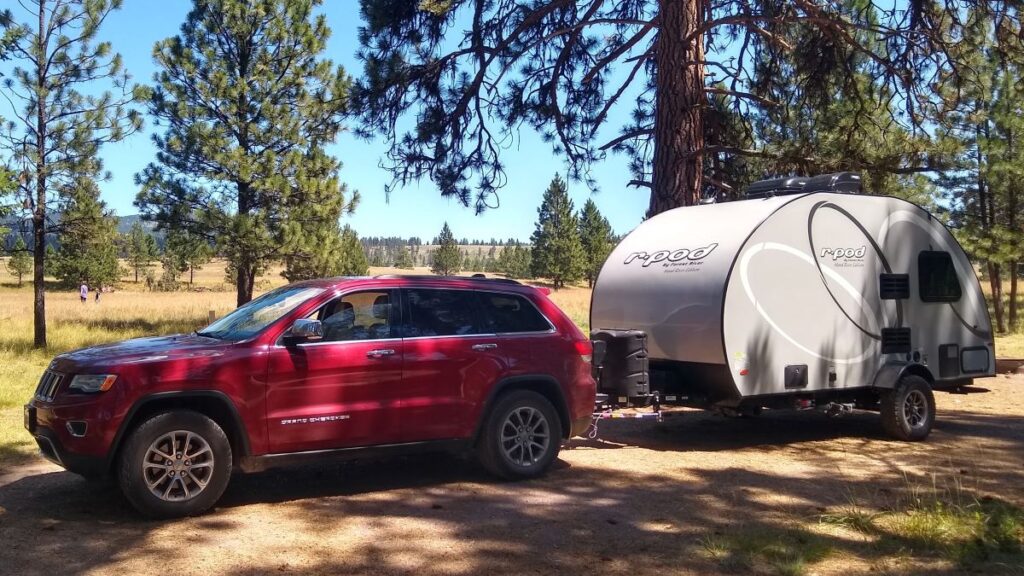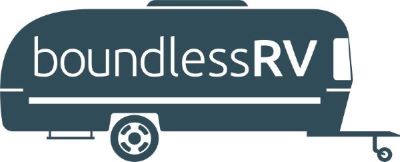First time towing? Or perhaps you’ve towed a small boat? Maybe drove a UHaul? Read on! This article covers traveling with a trailer in tow, from vehicle loading to driving tips and everything in between. We’ll go through the basics here and share some resources for those interested in learning more!
Tow Vehicle Capacities
First things first – what are you planning to use for the tow vehicle? You’ll need to make sure it’s capable and up to the job. Lookup the allowable weight capacities for your vehicle – typically these are listed in the Manual as well as a placard on the driver’s door frame. General RV’s database is a good resource, but be sure to confirm for your specific tow vehicle. First check that your vehicle’s Tow Capacity rating is well above the final fully-loaded trailer weight (trailer plus all cargo and liquids). You can find the trailer’s as-rented weight in the vehicle’s Camper’s Guide. In addition to Tow Capacity, you’ll also need to check that the tow vehicle stays within its Gross Vehicle Weight Rating (final safe-handling weight) – remember to include all fuel, cargo, and tongue weight from the trailer in the calculation. Each axle also has a weight rating – always read your vehicle’s Manual carefully and abide by it fully.
Next you’ll need to make sure your vehicle has the necessary equipment. All of our trailers require your vehicle to be equipped, at a minimum, with a working 7-pin electrical connector and 2″ (or larger) hitch receiver. You’ll also need a brake controller and hitch – bring your own or rent ours if needed (be sure to select the Tow Gear Package during checkout so we keep one available). Want to read more about tow capacities? Check out this article from Curt Manufacturing.

Trailer Weight & Balance
Next you need to properly load the trailer. Look at everything going into the trailer – clothes, food, fresh water, propane – everything! This all adds weight to the trailer (see Vehicle Capacities above), and most importantly also changes the balance. Imagine the trailer as a teeter-totter pivoting around the axle – you need to keep the weight distributed correctly to stay safe. Typically trailers require you to maintain a Tongue Weight of 10-15% of the Gross Trailer Weight. To do this you’ll need to put about 60% of the cargo weight forward of the axle and 40% behind the trailer axle. Remember to account for the weight of water or sewage in the tanks as well (8.4 lbs/gal)! We often have a tongue scale on hand if you want to check your tongue weight before heading out. Here’s a great demo from Weigh Safe showing how important this is.
Hitching Up
Finally time to get hooked up! Make sure the trailer is ready – contents are going to bounce and move, so put away everything loose and tie down furniture. Make sure the windows are closed, and that external access doors, hatches, and the front door are locked tight! Don’t be the driver who’s trailer door flies open on I-5! Curt Manufacturing provides a good overview of the hitch-up process in 10 Easy Steps. Also specific step-by-step instructions for each trailer are included in the Campers’ Guide for each vehicle. Before heading out confirm that all stabilizer/tongue jacks are stowed, the trailer lights are working, and the brake controller is calibrated (actuate the manual control on your brake controller – you should feel them working).
Driving Tips
Towing demands more attention and care than normal driving – read your tow vehicle’s manual carefully and abide by it. Take a few minutes pre-trip in an open parking lot to try out driving, cornering, and parking. Slow and steady will win this race! Of course, having your own kitchen and bathroom with you means you can take your time – enjoy the journey!
- Brakes – If you’ve towed smaller trailers in the past, this may be your first experience with electric trailer brakes. The electric brakes on the trailer are designed to work in unison with your tow vehicle, and need to be controlled by a car-mounted or portable brake control unit.
- Speed – Obey the speed limit for all roads (truck speed if posted). Particularly watch out for turns that require reduced speeds. Under no circumstances should you exceed 65MPH due to tire speed rating.
- Cornering – Remember to keep turns wide like a truck, following the outside of your lane, and that the trailer’s back end will swing out.
- Handling – Be cognizant of your increased width – narrow roads (for example in construction zones, and some 2-lane rural roads) sometimes allow only a couple inches of clearance on each side. Take it slow.
- Reversing – You have no rearward visibility – have a spotter outside help guide you!
- Height – The trailers are tall! Know your trailer’s clearance height. Keep an eye out for anything overhead- low bridges, tree branches, or roadside signs to name a few. The trailers will not fit in most drive-thru lines.
- Look down the road and anticipate – you’ll need to brake sooner to stop for obstacles or achieve cornering speeds
Hills and Mountains
Take it easy – you won’t be the fastest one on the road here! Going uphill keep an eye on tow vehicle oil and coolant temperatures – if temperatures start getting too warm then back off the pedal. Simply slowing down and allowing the transmission to downshift does wonders! Don’t be shy about using the slow lane to cross Snoqualmie Pass at 40MPH (hazard lights on). Downhill is easier on engine, but you must be careful to keep speed in check and not burn out the tow-vehicle or trailer brakes. Shift your transmission into a lower gear to allow the engine resistance to do the majority of braking for you. Gently pump the brakes in bursts as needed – never ride the brakes (they will burn and then fail).
This video from World Car Mazda New Braunfels is a nice summary of trailering techniques:
The Unexpected
- Trailer Sway – If you encounter the trailer swaying side-to-side, do not apply tow-vehicle brakes – a good response is to activate the trailer brakes manually via the brake controller. Then slow down gradually and consider what caused the sway – is the trailer loaded correctly? Is your speed too high for the conditions?
- Wind Gusts – Sudden bursts can come from terrain features, windy weather, or passing trucks. For most wind conditions I’ve had luck simply driving slower. In bad wind you’d want to wait out the weather.
- Flat Tire – A full-size spare tire is mounted to the back bumper. Verify your tow vehicle’s jack can hold the trailer’s weight. After replacing the tire, torque the lug nuts in a star-pattern to the appropriate torque. If you don’t have a torque wrench, a call to Roadside Assistance is a great option.
- Roadside Assistance – Need some advice or even roadside support to work through an issue? Contact Boundless RV anytime, or utilize your included Outdoorsy Roadside Assistance plan by calling 1-877-250-6731
Let’s Get Going!
Ready to hit the road? If you haven’t already, reserve your clean, modern, and fully-equipped Seattle/Redmond camper now! Feel free to reach out anytime with questions about towing or our vehicles, we’re happy to help!


